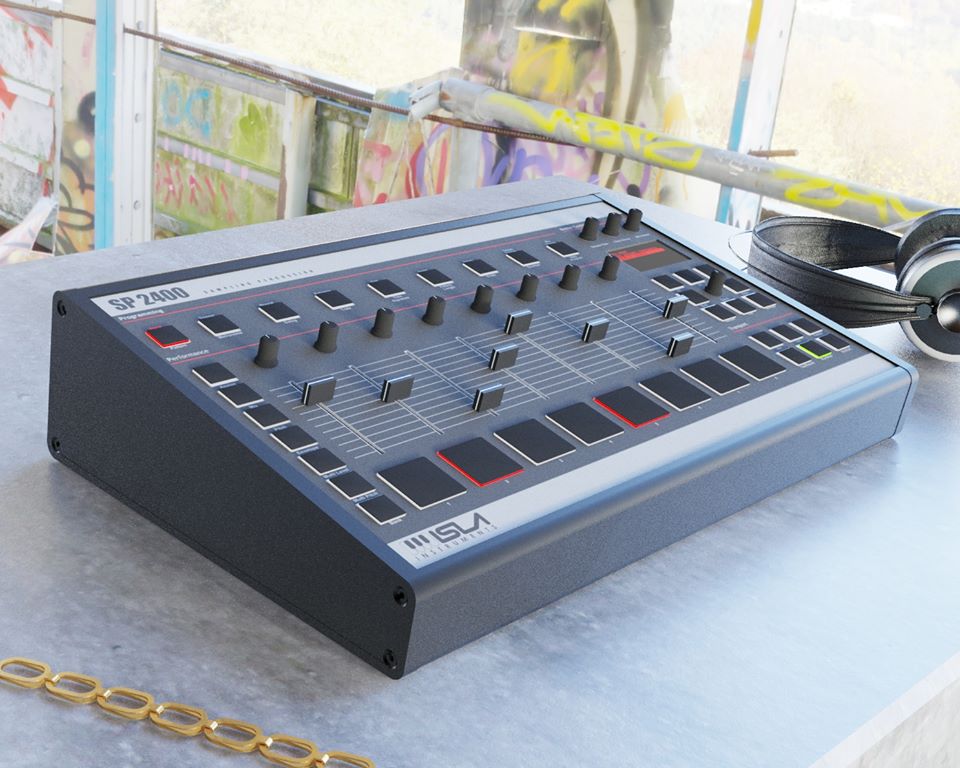
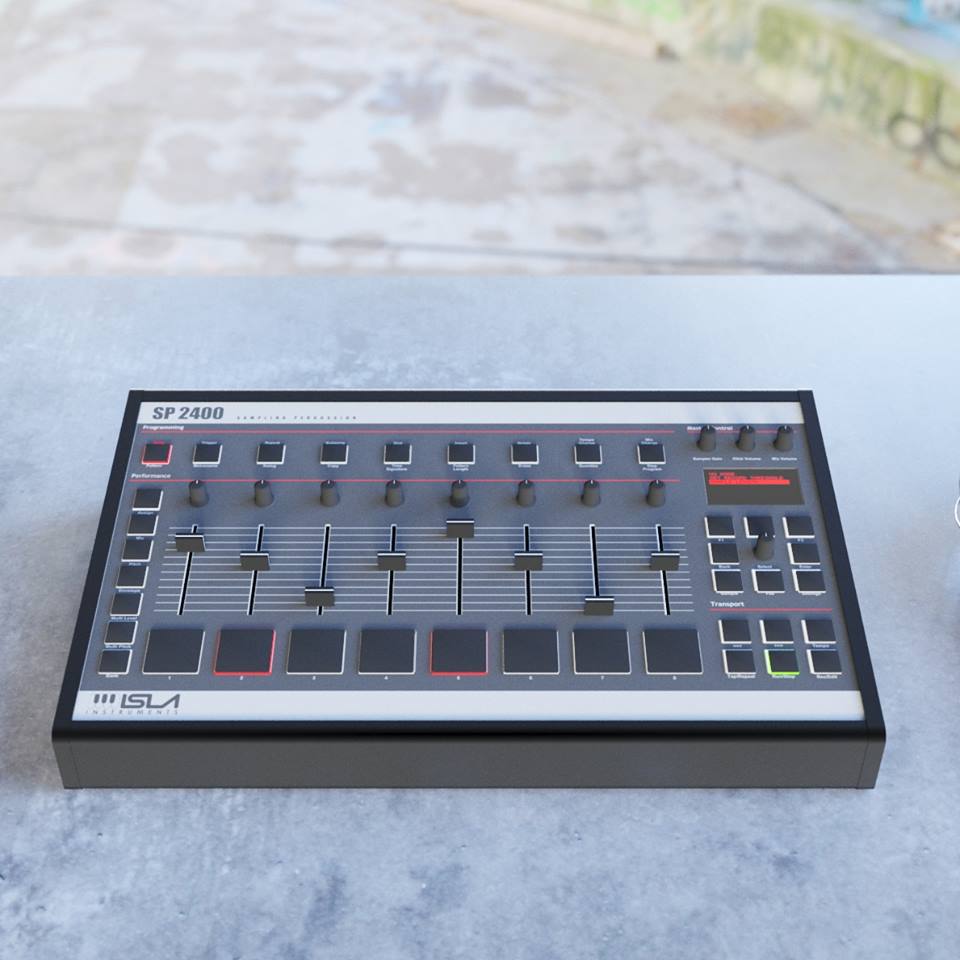
As you can see from the new Renders. Isla instruments (maker of KORDBOT) is behind the new SP 2400 product. I will have them on to discuss the news on my live youtube stream soon! https://www.islainstruments.com/
so many answers to come!



As you can see from the new Renders. Isla instruments (maker of KORDBOT) is behind the new SP 2400 product. I will have them on to discuss the news on my live youtube stream soon! https://www.islainstruments.com/
so many answers to come!
Doepfer dives deeper into industry-standard Eurorack small-format modular system with quirky quintet of polyphonic modules
GRAEFELFING, GERMANY: having made musical waves during a show-stopping showcase of prototypes closer to home at SUPERBOOTH18 in Berlin, Germany, esteemed electronic musical device designer Doepfer is proud to globally announce availability of its A-111-4 Quad VCO, A-105-4 Quad Poly SSI VCF, A-132-8 Octal Poly VCA, A-141-4 Quad Poly VCADSR, and A-190-5 Polyphonic USB/Midi to CV/Gate Interface — a quirky quintet of polyphonic modules that sees the trailblazing company diving deeper into the now-industry-standard Eurorack small-format modular system standard that it initiated and popularised with its ever-expanding A-100 ANALOG MODULAR SYSTEM — as of March 1…
Who better to throw light on the thinking behind this quirky quintet than company CEO Dieter Doepfer himself. “Modular synthesizers are almost exclusively monophonic structures since true polyphonic patches require a lot of modules — at least four VCOs, four VCFs, four VCAs, and eight ADSRs for a ‘classic’ four-voice patch,” he begins. “But even then it’s difficult to control filter resonance or modulation depth of all the filters, for example, or the attack and decay time of all the envelope generators simultaneously. So now it’s possible to integrate these functions into the modular synth world with our polyphonic modules, though the idea is not just to recreate a standard polyphonic synth within the modular system but rather realise new polyphonic structures that go far beyond a standard polyphonic synth and also far beyond the typical monophonic structures of a modular system since they still offer access to all parameters via CV or gate.”
Getting going, then,

the A-111-4 Quad VCO module features four precision CEM3340-based — triangle core — VCOs (Voltage Controlled Oscillators), each with its own separate internal +/- power supply (to ensure stability and prevent unwanted VCO synchronisation). Each VCO has the same individual controls, and inputs/outputs, as follows: 1V/Octave CV In (Control Voltage input); +1 / 0 / -1 Octave switch; Tune control, with ~ 2 semitones / ~ 1 octave / ~ 4 octaves range selectable via internal jumpers; Mod. (modulation) CV In (Control Voltage input); Modulation Destination — upper position equals exponential frequency modulation (XM) and lower position equals linear frequency modulation (LM) or pulse-width modulation of the rectangle waveform (PM), selectable via internal jumper; frequency modulation (FM) or pulse- width modulation (PWM) of the rectangle waveform; Mod. Level (modulation intensity); triangle waveform output; sawtooth waveform output; rectangle waveform output — about 50% without external pulse-width modulation; SYC (sync) input — (CEM3340-type) hard or soft sync selectable via internal jumper; and minimum 10 octaves range (with appropriate external control voltage). Continuing further down its familiar (silver-grey) front panel, a Master section for all four VCOs includes the following controls and inputs/outputs: 1V/Octave CV In (Control Voltage input); +1 / 0 / -1 Octave switch; Tune control, with ~ 2 semitones / ~ 1 octave / ~ 4 octaves range selectable via internal jumpers; exponential frequency modulation (XM) CV In (Control Voltage input); triangle waveform sum output; sawtooth waveform sum output; and rectangle waveform sum output. Typical applications include: fat-sounding monophonic VCO with the ability to adjust any intervals; paraphonic patches — when working in combination with the A-190-5 Polyphonic USB/Midi to CV/Gate Interface and all four VCOs being processed by one VCF/VCA section; fully polyphonic patches — when working in combination with the A-190-5 Polyphonic USB/Midi to CV/Gate Interface and four complete VCF/VCA sections; complex VCO patches with up to four VCOs by means of the — exponential and linear — frequency modulation features and sync functions.

Following in (traditional subtractive synthesis) sequence, the A-105-4 Quad Poly SSI VCF module is Doepfer’s first polyphonic filter, featuring four identical 24dB lowpass (SSM2044-type) filters. The module itself includes the following controls and inputs/outputs: F (frequency); FM (frequency modulation) intensity; Q (resonance); audio input L (level); CVF (control voltage frequency) attenuator; CVFM (control voltage frequency modulation) attenuator; CVQ (control voltage resonance) attenuator; CVL (control voltage level) attenuator; CVF (control voltage frequency) socket; CVFM (control voltage frequency modulation) socket; CVQ (control voltage resonance) socket; CVL (control voltage level) socket; FM (frequency modulation) 1 – 4 sockets; audio In (input) 1 – 4 sockets; and audio Out (output) 1 – 4 sockets, so each filter features a separate FM input as well as an audio input and output. The FM input is typically connected to the output of the associated envelope generator, such as Doepfer’s A-141-4 Quad Poly VCADSR, while the envelope amount for all four filters is controlled by the FM knob and the CVFM input by four built-in VCAs, which are also controlled by the FM control and CVFM input to also allow voltage control of the envelope amounts. Additionally, it is also possible to apply frequency modulation to all four filters — for example, using an LFO (Low Frequency Oscillator) patched into the CVF socket and using the associated (CVF) attenuator. The range of the audio input level (L) control also allows clipping/ distortion with typical A-100 ANALOG MODULAR SYSTEM audio levels — from, for example, the A-141-4 Quad Poly VCADSR module — at the filter inputs. This parameter is also voltage controllable, as is the resonance (Q). Applications include polyphonic patches requiring four VCFs with the same parameters.

Perfectly named, the A-132-8 Octal Poly VCA module is an octal VCA (Voltage Controlled Amplifier), primarily primed for polyphonic applications. As such, it includes four pairs of VCAs — each pair including two daisy-chained VCAs, with one VCA having a linear control scale and the other a linear or exponential control scale, selectable via internal jumpers. Two VCAs are provided for each voice since one VCA is usually required for the loudness envelope and another for velocity (or other functions like individual voltage-controlled loudness of each voice, amplitude modulation, and so on). All VCAs are DC coupled and can be used in specialised applications and also for processing control voltages. The module features two Default Gain controls — GL and GX — that enable opening of the first four VCAs (L) and/or second four VCAs (X), with GL and GX generating two internal (0 – +10V) control voltages which are connected to the switching contacts of the 1L – 4L sockets (controlling GL) and 1X – 4X sockets (controlling GX). If no patch cable is inserted into the socket in question then the internal default (GL or GX) control voltage is used to control the corresponding VCA. This is necessary when the VCA in question is not in use — when no external control voltage is available, for instance, otherwise the VCA would close and there would be no output signal even if the other VCA in the chain is open. On the other hand, as soon as a patch cable is inserted into one of the CV Inputs then the corresponding internal default control voltage — CL or CX knob — is no longer used to control the VCA in question; rather an external control voltage patched to the CV Inputs now controls the level of the VCA in question. The GL and GX controls are also useful for testing polyphonic patches — tuning VCOs, for example.
Again, as implied by name,

the A-141-4 Quad Poly VCADSR module is a quad voltage-controlled envelope generator — again, primarily primed for polyphonic applications. As such, it features four ADSR-type voltage-controlled envelope generators with exponential curve shapes (charge/discharge curves of a capacitor). Common manual controls and CVA, CVD, CVS, and CVR inputs with corresponding polarizers are available for the attack (A), decay (D), sustain (S), and release (R) parameters. All four envelope generators have a gate input (G1 – G4), a control LED, and an envelope output (Out1 – Out4). Applications include polyphonic patches, such as four envelope generators with the same envelope parameters to control four VCFs, VCAs, or other modules.
Last, but by no means least, by providing four voices with a 1V/octave-standard CV Note (pitch control voltage) to control VCOs and a Gate output (to control envelope generators), alongside two additional (CV2 and CV3) control voltages, the appropriately-named

A-190-5 Polyphonic USB/Midi to CV/Gate Interface module does what it says on the tin. Those two additional control voltage outputs can be controlled by MIDI velocity, volume, modulation, pitch bend, aftertouch, or freely-assignable MIDI controllers. Multiple — four-voice monophonic (to control four monophonic voices by four successive MIDI channels); four-voice polyphonic (to control four monophonic voices by one MIDI channel) with several (rotating/non-rotating) sub-modes; two-voice polyphonic (to control two monophonic voices by one MIDI channel); and unison — modes are selected by switches with the result shown in the LCD. In play mode, for example, the LEDs of the first four switches display the gate states, while certain parameters of each mode can be edited.
Ending on a high note, Dieter Doepfer deduces, “Modular synthesizers will still be predominantly used for monophonic sounds, as I’m well aware, but at least one polyphonic sound appears in many pieces of music and now it’s possible to integrate this into the modular synth world with our polyphonic modules.”
Within Germany, the A-111-4 Quad VCO, A-105-4 Quad Poly SSI VCF, A-132-8 Octal Poly VCA, A-141-4 Quad Poly VCADSR, and A-190-5 Polyphonic USB/Midi to CV/Gate Interface modules can be ordered online from Doepfer directly (https://www.doepfer.de/form_e.htm) or via one of its German dealers (https://docs.doepfer.eu/en/dealer-germany/) for €400.00 EUR, €200.00 EUR, €160.00 EUR, €160.00 EUR, and €300.00 EUR, respectively.
Outside of Germany, the A-111-4 Quad VCO, A-105-4 Quad Poly SSI VCF, A-132-8 Octal Poly VCA, A-141-4 Quad Poly VCADSR, and A-190-5 Polyphonic USB/Midi to CV/Gate Interface modules can only be ordered from Doepfer dealers in the territories listed here: https://docs.doepfer.eu/en/ (Note that residents in countries without representation can, however, order from Doepfer directly.)
For more in-depth information, please visit the dedicated A-111-4 Quad VCO webpage here: https://www.doepfer.de/A1114.htm
For more in-depth information, please visit the dedicated A-105-4 Quad Poly SSI VCF webpage here: https://www.doepfer.de/a1054.htm
For more in-depth information, please visit the dedicated A-132-8 Octal Poly VCA webpage here: https://www.doepfer.de/a1328.htm
For more in-depth information, please visit the dedicated A-141-4 Quad Poly VCADSR webpage here: https://www.doepfer.de/a1414.htm
For more in-depth info, please visit the dedicated A-190-5 Polyphonic USB/Midi to CV/Gate Interface webpage here: https://www.doepfer.de/a1905.htm
take a gander at the video… some nice info and photos for ya.
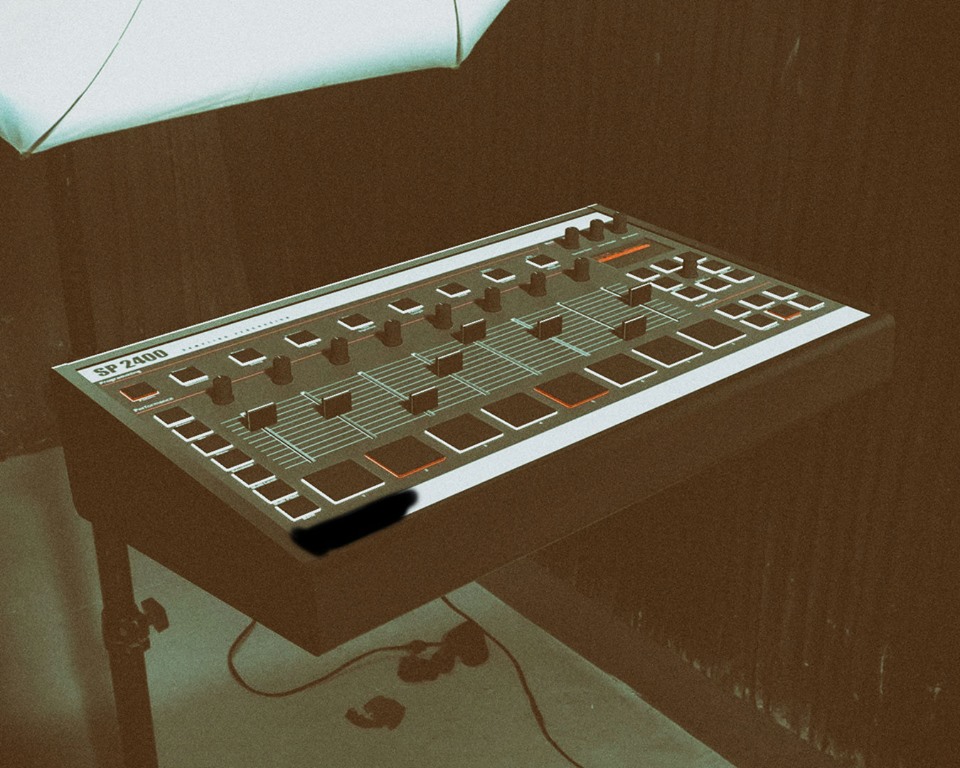
What if I told you the SP 2400 is real… its not Behringer and Its NOT E-MU/Rossum. It is going to be built as a proper spiritual successor to the classic sampler many of us have grown to love so dearly. This is no clone, this is something more…
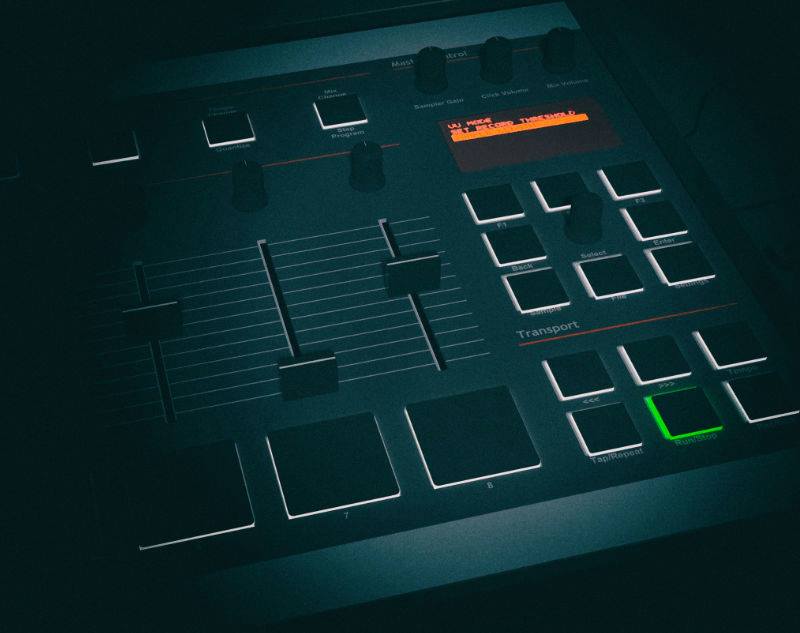
Recently I came across a post showing what appears to be a circuit board for a “sp-2400” this name has long been tossed about in forums and back Alley dives as to what the successor to the famed sp-1200 could be. Over the years there have been many rumors, requests and out right denials from those involved in the classic sampler.

So what is speculation and what is fact?
FACTS…..24bit AND 12 bit, Aluminum construction, Classic sound with the Classic workflow. Filters per output, ability to sample with filter input or direct to dac. Features both usb host and client, Each pad will play cowbells (if you sample a cowbell to it) its not behringer… it is real, and it IS COMING SOON
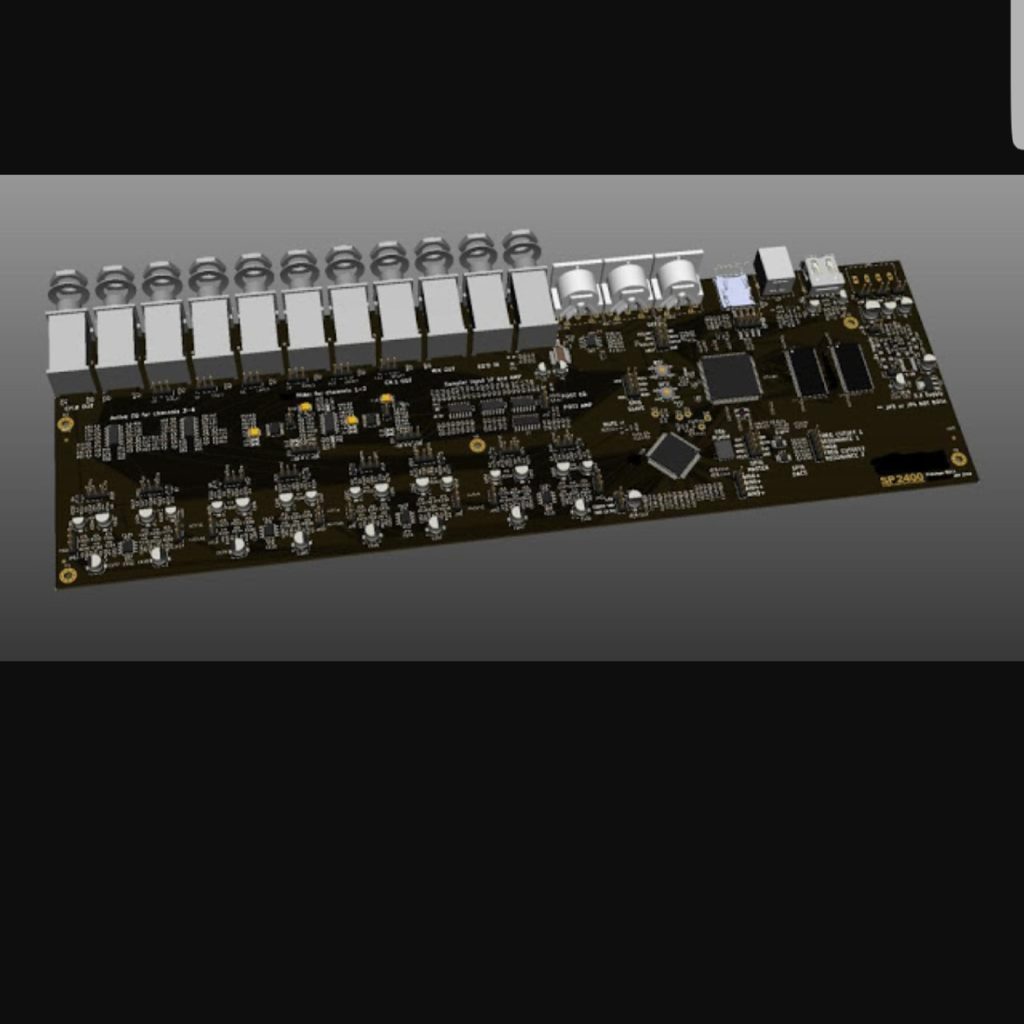
How do I know all of this? well I was given the info directly from the manufacturer. I have basically been given a slow stream of info… I myself still do not know the release date, the price point, what info is on the screen and how the screen functions… I will give info as I can.
I can tell you… I have heard it (audio comparisons sent to me of an early build)… it sounds fantastic. It is going to make many of us very happy… and the corksniffers… so mad. I will be dropping random tid bits about this as they fall out the back of the secret laboratory this is being built in.
So I am fortunate enough to have the only RD-808 outside of Behringer offices… so here is a very early taste of what is to come. check the video out.
Prism multi-dimendonal signal processor, Chord v2, Bloom fractal sequencer.
Prism
Multi-dimensional signal processor with stereo inputs and outputs.An assortment of DSP effects mapped to a 3-dimensional sonic space. ETA: March
MSRP: $249

Chord v2
Half the size – twice the functionalityPolyphonic oscillator in 14HP – custom chords, new wavetables, and four voice polyphonic mode
ETA: May
MSRP: $299
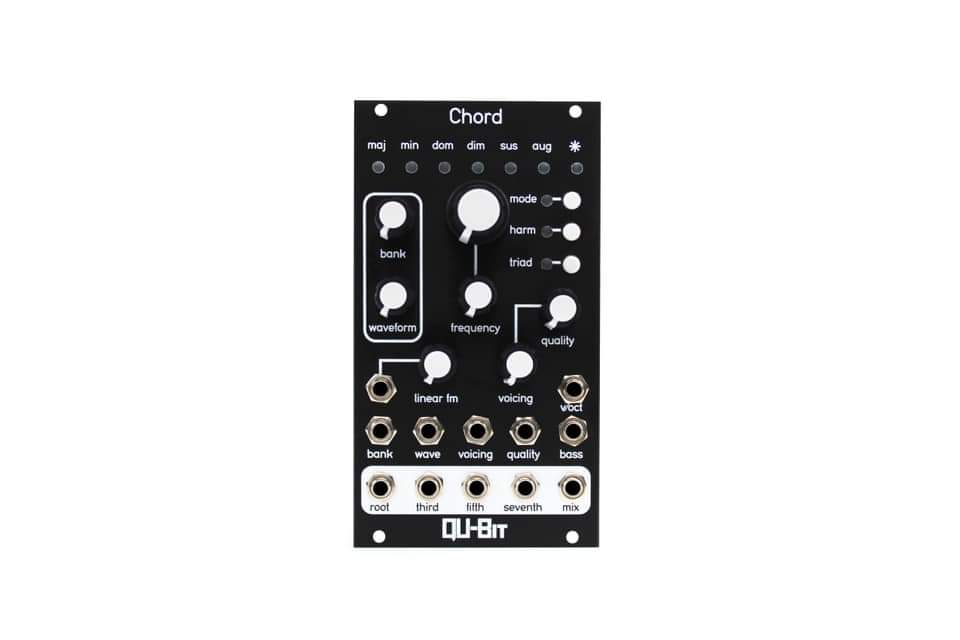
Bloom
Fractal sequencer32 step sequencer with 2 channels, pattern saving and an infinite number of variations from our fractal algorithm.
ETA: September
MSRP: $329

At the 2019 NAMM Show, Arturia is introducing the MicroFreak – described as ‘a peculiar, exceptional instrument that rewards the curious musician’.
The MicroFreak is a hybrid digital + analog synth that is built around a unique, expressive touch keyboard:

Here’s what they have to say about it:
Whether you’re looking for your first, affordable hardware synth or are collector looking for original sounds and unique interface, MicroFreak is the synth you need.
This out-there little music machine features a versatile digital oscillator so you can create rare and interesting sounds with ease. Modes like Texturer, KarplusStrong, Harmonic OSC, and Superwave give adventurous musicians the chance to explore totally new, unheard possibilities. Like having dozens of synths in just one instrument, both wild-eyed newcomers and seasoned professionals will fall in love with MicroFreak’s flexible, powerful synth engine.
MicroFreak packs so much in to such a compact instrument, you’ll wonder how we did it. We’d love to say it was magic, but it was pure skill and passion.
Features:
Pricing and Availability
The Arturia MicroFreak is expected to be available Spring 2019, priced at US $349
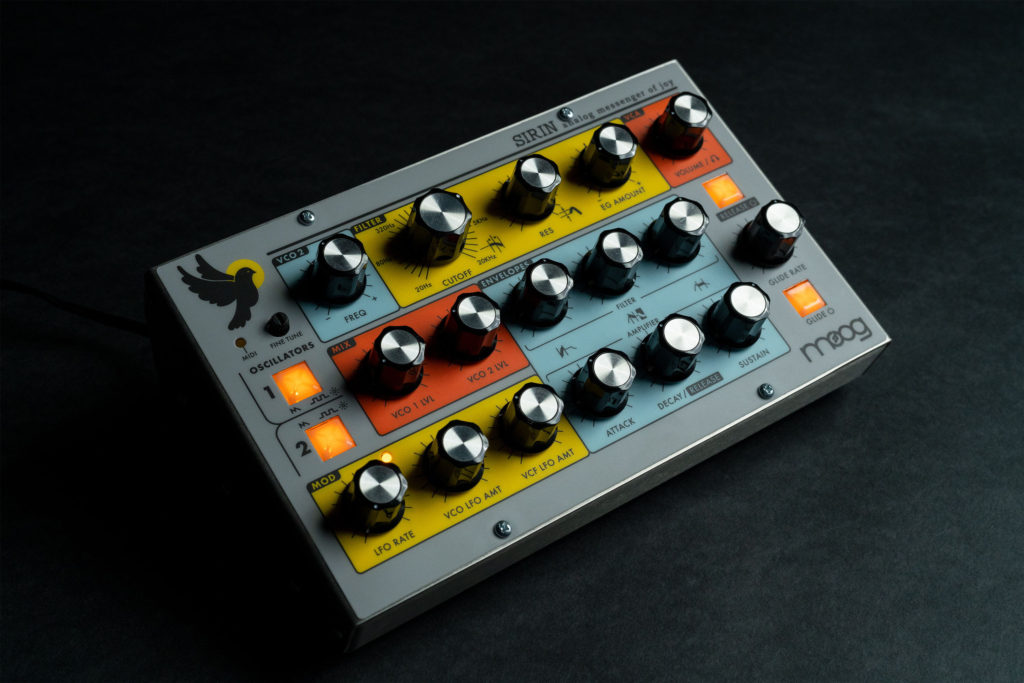
| MOOG MUSIC DEBUTS LIMITED EDITION SYNTHESIZER AT LA POP UP |
| Sound has the power to evoke feelings and images, translating energy from one level of reality to another. Musical experience brings us into contact with these transpersonal realities through the intelligent organization of sound waves. Artistry is in fact the art of translation.ABOUT SIRIN Sirin is a limited-edition synthesizer module created in celebration of the Moog House of Electronicus Pop-up experience. Based on the legendary Moog Taurus sound engine, and presented in the familiar compact form of the Moog Minitaur–Sirin is the first instrument in Moog’s Taurus family of bass synthesizers designed to generate pitches far above above middle C, with an extended frequency range that reaches notes up to D8. Connect Sirin directly to any MIDI-note controller and immediately access a portable world of powerful analog sound, or hook up to a computer via USB to explore even deeper layers of sound design, where every parameter can be manipulated, automated, and recalled using Sirin’s dedicated Editor Librarian Software (free download for PC and Mac).Secured in a brushed stainless steel enclosure with a retro-inspired color palette, Sirin is an intoxicating conjuror of both quintessential leads and menacing Moog bass. Sirin’s fully-recallable analog sound engine originates with two analog Taurus Bass oscillators that have been re-engineered to soar octaves beyond the traditional boundaries of its mythical ancestors. Sirin’s harmonic transmissions are dynamically shaped and sculpted by a classic Moog Ladder filter operating in consummate harmony with two lightning-fast ADSR envelopes and a multi-wave LFO, offering a wide spectrum of expressive timbral variety and versatility.Sirin integrates seamlessly with modern computer-based production environments via its dedicated Editor Librarian software (available as a free download for registered Sirin owners)–manage patches, automate parameters, unlock 6 additional LFO waveforms, engage Hard Sync, load up to 128 presets into Sirin, access full ADSR envelopes and more as you explore the vast magical realms of analog synthesis.A limited production run of 2500 Sirin are being produced by the employee-owners at the Moog Factory in Asheville, NC–after which no more will be available.Sirin will officially debut at the Moog House of Electronicus Pop-Up in LA’s historic Chinatown. During the week of Jan 24 – 30, Sirin will be available for purchase exclusively at www.mooghouseofelectronicus.com (US only) and on site at the Moog House Of Electronicus Pop-up (712 N Figueroa St, Los Angeles, CA 90012, 1/24/19-1/30/19), after which, the remaining synthesizers will be distributed world-wide.SIGHT & SOUND In this video from Moog Music, Nick Sanborn (Sylvan Esso, Made Of Oak) explores the power of sound using Sirin and DFAM analog synthesizers. Sanborn weaves multiplexed patterns of sound waves–translating the thoughts and feelings of the collective individual into a shared musical experience.With the exception of the DFAM’s percussive analog backbeat, all sounds in this video come from Sirin. Nick Sanborn uses the free downloadable Sirin Editor Librarian software to automate and recall parameter settings as he layers multiple monophonic tracks from Sirin.Sirin is now shipping and all orders placed through the House of Electronicus website will ship within 5-7 business days of order.ABOUT THE MOOG HOUSE OF ELECTRONICUS The Moog House of Electronicus is a synth-guided exploration of the power of sound, inspired by the Moog Island Of Electronicus; an experimental gathering that took place on the barrier island of Tierre Verde during the 1970s. After Moog missionary David Van Koevering was presented with a vision in a dream, the Island of Electronicus became manifest–a synthesized celebration of peace and love; an electronic happening designed to unite mind, body, and soul in a creative explosion of thought and feeling. Today, the Moog House Of Electronicus continues this legacy by inviting all to trust their curiosity, express their innermost selves, and share in the vast creative force of the collective individual.The Moog House of Electronicus Pop-up is open to the public daily from 12pm – 8pm, Thursday, January 24th – Wednesday, January 30th. Visitors will have the opportunity to get hands on with Moog synths (including Sirin and the new polyphonic Moog One synthesizer), as well as explore the deeper dimensions of sonic experience through interactive sculptural synthesis installations, an immersive audio visualization system, and daily synthesizer workshops led by synthesist Bana Haffar. Workshop space is limited–those in the LA area can sign up at here to reserve a space. |